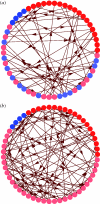Estimation of measles vaccine efficacy and critical vaccination coverage in a highly vaccinated population
- PMID: 20392713
- PMCID: PMC2988255
- DOI: 10.1098/rsif.2010.0086
Estimation of measles vaccine efficacy and critical vaccination coverage in a highly vaccinated population
Abstract
Measles is a highly infectious disease that has been targeted for elimination from four WHO regions. Whether and under which conditions this goal is feasible is, however, uncertain since outbreaks have been documented in populations with high vaccination coverage (more than 90%). Here, we use the example of a large outbreak in a German public school to show how estimates of key epidemiological parameters such as the basic reproduction number (R(0)), vaccine efficacy (VE(S)) and critical vaccination coverage (p(c)) can be obtained from partially observed outbreaks in highly vaccinated populations. Our analyses rely on Bayesian methods of inference based on the final size distribution of outbreak size, and use data which are easily collected. For the German public school the analyses indicate that the basic reproduction number of measles is higher than previously thought (R(0) = 30.8, 95% credible interval: 23.6-40.4), that the vaccine is highly effective in preventing infection (VE(S) = 0.997, 95% credible interval: 0.993-0.999), and that a vaccination coverage in excess of 95 per cent may be necessary to achieve herd immunity (p(c) = 0.971, 95% credible interval: 0.961-0.978). We discuss the implications for measles elimination from highly vaccinated populations.
Figures






References
-
- Anderson R. M., May R. M. 1991. Infectious diseases of humans. Dynamics and control. Oxford, UK: Oxford University Press.
-
- Ball F., O'Neill P. D. 1999. The distribution of general final state random variables for stochastic epidemic models. J. Appl. Probab. 36, 473–491. (10.1239/jap/1032374466) - DOI
-
- Becker N. G., Britton T. 2004. Estimating vaccine efficacy from small outbreaks. Biometrika 91, 363–382. (10.1093/biomet/91.2.363) - DOI
MeSH terms
Substances
LinkOut - more resources
Full Text Sources
Medical
